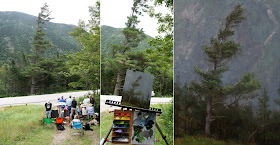Andrew Payne and I sat down last week and discussed drawing the figure and cast, as well as a few thoughts on Colleen Barry's structure drawing class and the atelier process. Andrew is a second year student in the GCA core program, originally from Salt Lake City, Utah.
-Connor de Jong
 |
| Samir Head by Andrew Payne |
Andrew: I have been trying to get some experience and practice with line quality in Colleen’s class. That’s something that Josh [LaRock] has talked to me about before too - using line to describe the form or the structure of what you’re seeing, rather than just having all of the lines be the same. Colleen’s class taught me to use lines to create overlaps and fullnesses, and she would say, “Certain parts of the figure - where it’s not a contour - have a broken line. You don’t want uniform lines everywhere.”
The ability to focus on those things enables you to see so many more things that you haven’t noticed before (at least for me). She gave me events to look for: high points, low points, overlaps, fullnesses - points where the line breaks.
Some of my favorite drawings are not even fully rendered - just to be able to use all these different tools and ideas to create something that looks like it could move off the page without even being fully rendered is exciting.
Also, Colleen has really helped me with handling distance from the models; sometimes there are 10 or 12 feet between you and the model, and you can't really get away with too much without truly knowing the structure of the figure. At that distance, I can’t even really see the model’s face too well, so this knowledge becomes very important. It’s fun. I can see where people can get really creative - you have to conceptualize this thing. Sometimes I enjoy that even more than when you can see the model very clearly.
 |
| Samir by Andrew Payne |
Connor: In a way, we’re looking at the melding of the cast program and the focus on form with conceptual knowledge in the figure - a pretty hefty topic.
One facet of figure drawing that Colleen discusses is playing around with the picture plane. She talks about it almost as if it’s a puzzle, the way the pieces interlock and intersect, the way you push things back and forward - not necessarily in a form sense, but in the visual, compositional sense.
Andrew: Yeah, she talks about the hierarchy, how you can make it whatever you want - it doesn’t have anything to do with form necessarily.
Connor: There’s something nice about that, it feels like there is a sense of control as a piece of designed art, rather than just an undecided depiction. That element of figure drawing is hugely important. How do you design a beautiful figure?
 |
| Collin by Andrew Payne |
Andrew: It’s hard. In the Anthony Ryder book - I think he’s talking specifically about rendering form in the figure - and he says that if you try to just copy what you’re seeing, obviously it’s not going to look very good. I think it’s also true that at the beginning stage of a block in, it’s possible to make it look okay by copying; but, if you’re only copying what you’re seeing, it probably won’t look that great. That’s why all the teachers here know anatomy and the structure of the figure.
Colleen talks about how you want to find that rhythm of the figure; where things are pinched and where they are stretched, where there is tension. That’s why it’s important to know where all the muscles connect. A leg can have rhythm by itself, but you want the whole figure to have it, all the parts and individually. For instance, the leg can look stiff unless the high points are placed diagonally from each other in a sort of zig zag [motions leg high points]... and it’s always like that on the model, but unless you know that, you don’t notice it.
Connor: When drawing the figure, you realize pretty quickly - like you said - that you can’t just copy it. Models are people and they move, and they never truly go back to that same position again.
Andrew: And part of that is liberating, after you’ve been in the Cast Hall... It’s a lot different drawing a cast versus the figure - you’re like, “Wow, I don’t have to be “perfect”, because there is no perfect. It becomes more of a creative thing, and I enjoy it a lot more than drawing casts.
I’m still trying to find this balance between drawing and measuring, and drawing optically versus structurally - they’re all different things, but when Colleen demonstrates to me, “I mark the top and the bottom of my drawing at the beginning, and I want my drawing to fit in here,” I think, ”Whoa, I have to fit it exactly within these measurements...” That’s a lot of pressure.
 |
| Santiago by Andrew Payne |
However, she tells me to use measurement as a safety net; to check things every once in a while - sure, find the half just to have something to base your conception on from the beginning, but I’m surprised by how well she draws without measuring all that much. It can be really stifling to measure all the time, sometimes I feel like it’s kind of a bad habit I got into in the Cast Hall, just measuring every little thing. It’s easy to do because the cast doesn’t move and it’s easier to measure.
Connor: I feel that too - it’s good and bad to measure a lot. It can be good, especially in the Cast Hall, because you develop a sense of measurement for your eye. Every time you measure by hand there is also a mental check by eye first. So you develop a sense for comparing spaces… sometimes, for whatever reason, you can be completely tricked - but if you have been measuring by hand a lot, your ability to gauge distance by eye tends to be very close.
Andrew: Yeah, it’s a definite difference. When I first started last year - even when I would try to measure a half - I would be so far off, I would think, “How could I be that far off on a half?” [laughter] It’s definitely interesting, when Michael Klein came in last year, when looking at my cast painting he said, “Maybe I wouldn’t measure so much, I don’t like to measure.” I usually measure a lot at the beginning, as we’re taught, but I love the part where you get to the drawing. When the really rough block in is there and I can just put my knitting needle [measuring tool] away and draw.










































